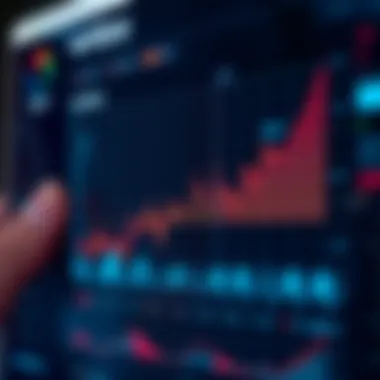Understanding Worldpay Tokens in the Cryptocurrency Realm


Intro
In the realm of digital finance, cryptocurrency continues to break new ground. Worldpay tokens represent an intriguing aspect of this ecosystem, showcasing how tokenization can enhance transaction dynamics. This article aims to peel back the layers of Worldpay tokens, elucidating their role in the cryptocurrency space and drawing comparisons with traditional payment systems. For those eager to understand the mechanics behind Worldpay tokens, this exploration will reveal their potential in revolutionizing digital payments.
Understanding Cryptocurrency Fundamentals
Key Concepts of Blockchain Technology
To get a grip on Worldpay tokens, one must first grasp the foundational principles of blockchain technology. Blockchain is essentially a distributed ledger. Picture it as a digital notebook shared among a network of users. Each entry, or block, is linked to the previous one, forming a chain. This interconnected structure ensures not only transparency but also security, as altering any single block would require changing all subsequent blocks.
- Decentralization: In a world where central authorities often govern financial transactions, blockchain flips the script. It empowers individuals, removing the need for intermediaries like banks.
- Immutability: Once information is recorded on the blockchain, it remains unchanged. This characteristic is crucial for maintaining trust in transactions.
- Smart Contracts: These are self-executing contracts with terms directly written into code. They enhance automation and efficiency, minimizing the risk of human error.
Types of Cryptocurrencies and Their Uses
Cryptocurrency is not a monolith—just as you wouldn’t group all fruits together, each cryptocurrency serves a unique function. Here are a few notable types:
- Bitcoin (BTC): The original cryptocurrency, birthed in 2009, Bitcoin is often dubbed digital gold. Its primary use is as a store of value and means of exchange.
- Ethereum (ETH): Known for its programmable features, Ethereum serves as a platform for smart contracts and decentralized applications (dApps).
- Stablecoins: These are pegged to real-world assets like the US dollar, reducing volatility and making them suitable for everyday transactions.
In light of these categories, Worldpay tokens emerge as another type, focused specifically on streamlining payment processes.
Analyzing Market Trends
Tools and Techniques for Market Analysis
Market analysis in crypto isn’t just for the faint-hearted; it requires a blend of intuition and solid tools. Traders often rely on several approaches, such as:
- Technical Analysis (TA): Using historical price data and patterns, traders make predictions about future movements. Think of it as reading tea leaves, where charts reveal potential opportunities.
- Fundamental Analysis (FA): This involves looking at the overall health of a cryptocurrency project—factors like the team's credibility, use case, and market demand play vital roles.
- Sentiment Analysis: Platforms like Reddit and Twitter can provide insights into public perception. The mood of the crypto community can sway market trends faster than you can say "bull run".
Identifying Emerging Trends in Crypto Investing
Staying ahead in the crypto world requires a keen eye for trends that can shape the market. Here are some emerging trends:
- Increased Adoption of Cryptocurrencies: More businesses are accepting digital currencies for payment, pushing mainstream acceptance.
- Regulatory Changes: As governments begin to understand the landscape, new regulations can significantly impact token values.
- Growing Interest in Decentralized Finance (DeFi): DeFi projects are gaining traction, allowing individuals to lend, borrow, and trade without traditional financial institutions.
Culmination
Understanding how Worldpay tokens fit into the broader world of cryptocurrency demands a strong grasp of both blockchain fundamentals and market dynamics. As this article progresses, we’ll delve deeper into the specific applications of Worldpay tokens, their benefits and challenges, and how they measure up against conventional payment mechanisms. Stay tuned for a detailed examination of how these tokens can potentially revolutionize the way we look at digital transactions.
Understanding Tokens in Cryptocurrency
In the ever-evolving world of cryptocurrency, tokens play a pivotal role in enhancing functionality and accessibility. Understanding tokens is not merely an academic exercise; it is fundamental for anyone looking to navigate the digital economy effectively. They serve as the backbone of numerous applications within the blockchain ecosystem, bringing together technology, finance, and user engagement in innovative ways.
Knowing how tokens operate is crucial for investors, traders, and enthusiasts alike. This knowledge can provide insights into investment opportunities, tech advancements, and even regulatory developments. The different types of tokens also highlight the various philosophies behind their creation and use.
Definition of Cryptocurrency Tokens
Cryptocurrency tokens are digital assets created on a blockchain, often representing an asset or utility. While the term "token" might seem synonymous with "coin," the distinction is important. A coin like Bitcoin operates on its own blockchain and serves primarily as a digital currency, whereas tokens often rely on existing blockchains—typically Ethereum. These tokens can represent anything from an asset to a stake in a project.
Given their versatility, tokens can provide various functionalities within decentralized applications, widely known as dApps. They can facilitate exchanges, access resources, and even reward community participation.
Types of Tokens
The cryptocurrency landscape features several types of tokens, each serving unique functions and purposes. The primary categories discussed here will include Utility Tokens, Security Tokens, and Asset-Backed Tokens.
Utility Tokens
Utility tokens are designed to provide holders with access to a product or service within a blockchain ecosystem. For instance, consider a new platform for sharing digital content. Users might pay with utility tokens to access premium features like additional storage or exclusive content.
A defining characteristic of utility tokens is their non-investment nature. They are not meant solely for speculation; instead, their value is derived from the demand for the services they unlock. This can make them popular among new projects seeking to build an engaged user base quickly.
However, they come with some caveats. Their value can fluctuate wildly depending on market interest in the platform and its offerings, meaning that speculative investment can lead to high risk as well.
Security Tokens


On the other hand, security tokens are more like traditional investment vehicles. They represent ownership in an asset, such as stocks or real estate, and are typically subject to regulatory oversight. The key characteristic of security tokens is that they often comply with laws governing securities, making them appealing to investors looking for regulated investment opportunities.
Specifically, the unique feature of security tokens is their backing by tangible assets or revenue streams, which lends them a degree of stability compared to utility tokens. However, this also means they face complex regulatory hurdles, making their issuance and trading more cumbersome.
Asset-Backed Tokens
Lastly, there's the category of asset-backed tokens, which are directly tied to physical assets like gold, real estate, or even fine wine. These tokens provide a unique advantage in terms of value stability, as they directly reflect the market worth of the assets they represent. Unlike utility and security tokens, asset-backed tokens aim to minimize the volatility commonly associated with cryptocurrencies. This can appeal to investors seeking safer options in a turbulent market.
Nevertheless, the confusion around asset valuation and legal ownership can pose challenges. Ensuring that the asset truly backs the token is crucial, which often requires comprehensive auditing and transparency.
Worldpay and the Ecosystem of Digital Payments
In today's fast-paced world, digital payments have become a crucial part of how we conduct business. At the heart of this evolving landscape lies Worldpay, a key player that has significantly impacted the ecosystem of digital finance. Understanding the role of Worldpay and how it integrates with various payment methods sheds light on the broader implications for businesses and consumers alike.
The Role of Worldpay in Fintech
Worldpay operates as a premier payment processing company, and its influence in fintech is nothing short of substantial. The firm serves a wider audience by offering tailored solutions for merchants, empowering them to accept payments through various channels. This could be from credit card swipes at a brick-and-mortar store to mobile wallet payments, showcasing the immense flexibility and reach Worldpay has in the digital payments arena.
In a nutshell, Worldpay supports both small enterprises and large corporations, providing a robust platform that facilitates secure transactions. This role goes beyond merely processing payments; it encompasses enhancing user experience, reducing fraud, and integrating advanced technologies like artificial intelligence to tailor services to specific business needs.
Moreover, by working in compliance with local regulations, Worldpay fosters trust among users, which is essential in sustaining the fintech ecosystem. It's a fine line, maneuvering through the regulatory landscape while still pushing for innovation, but Worldpay has managed to do so effectively.
Evolution of Payment Technologies
The landscape of payment technologies has undergone radical changes, and Worldpay has been at the forefront of many shifts. Initially, payment processes were largely manual, relying heavily on physical interactions. However, the advent of the internet ushered in an era of online transactions where speed and efficiency became paramount.
Worldpay has kept pace with these advancements, continuously upgrading its systems. From traditional credit card terminals to virtual payment gateways, this evolution has been driven by changing consumer preferences. People want convenience, and as smartphones and digital wallets emerged, Worldpay adapted its offerings accordingly.
The introduction of contactless payments and blockchain technology are also pivotal moments in this evolution. Worldpay’s exploration into embracing cryptocurrencies has made the payment process quicker while instilling a sense of transparency and security that modern consumers demand. The integration of technology into payment processing is indeed a move towards a cashless society, making transactions easier not just for users, but for merchants who can tap into previously unreachable markets.
"The future of payments is digital, and companies like Worldpay are leading the charge in making these innovations accessible to everyone."
In summary, Worldpay’s role in fintech and the evolution of payment technologies illustrate a much larger narrative about how businesses and consumers are continually adapting. The advances made in digital transactions set the stage not only for Worldpay’s success but also for the potential growth of the entire digital payments ecosystem. By bridging the gap between traditional methods and modern solutions, Worldpay exemplifies the dynamic nature of today's financial landscape.
With these insights, we can now transition to understanding the concept of Worldpay tokens, where the game truly shifts for digital transactions.
The Concept of Worldpay Tokens
Understanding Worldpay tokens is crucial for grasping their role in today's cryptocurrency landscape. These tokens are not only a technological innovation but also a significant turning point in how transactions are processed in the digital realm. By integrating Worldpay tokens into their operations, businesses are opening the door to a plethora of benefits that enhance both security and efficiency in digital payments.
What are Worldpay Tokens?
Worldpay tokens are forms of digital assets that facilitate and simplify transactions within Worldpay’s payment processing ecosystem. Essentially, they act as a bridge between traditional financial systems and the blockchain world. Their design provides a layered structure where sensitive information is tokenized, thus keeping the actual data hidden from prying eyes.
For example, when a consumer makes a payment via Worldpay, instead of transmitting vital information like a credit card number, the system generates a unique token. This token can be used for processing without revealing any underlying critical information. Therefore, if a cybercriminal manages to intercept the transaction, all they would find is a meaningless string of characters, rendering their efforts futile.
How Worldpay Tokens Function
The functionality of Worldpay tokens hinges on the concept of tokenization. This process involves several key steps:
- Token Generation: Once a consumer initiates a transaction, Worldpay’s system generates a token. This token is unique to that transaction and cannot be reused.
- Data Protection: During the transaction, only the token travels through the networks, ensuring that sensitive information remains safeguarded.
- Real-Time Processing: The token acts as a placeholder while the actual details of the transaction remain hidden. This allows for almost instantaneous processing speeds compared to traditional methods.
- Reconciliation: After the transaction is completed, the underlying data can be matched back to the original token, allowing merchants to manage their sales data without ever exposing sensitive information.
Using Worldpay tokens not only enhances the security of transactions but also streamlines the process. This holds particular importance for businesses handling a high volume of transactions that need to be processed efficiently without compromising security. As fintech continues to evolve, the relevance of Worldpay tokens is poised to grow, fostering a safer and swifter digital payment environment.
Benefits of Using Worldpay Tokens
In the landscape of digital payments, Worldpay tokens bring a host of advantages that significantly enhance both security and transactional efficiency. Understanding these benefits is crucial for investors, traders, tech enthusiasts, and students keen on navigating the complexities of cryptocurrency. This section sheds light on specific elements that make Worldpay tokens a game-changer in how payments are processed today.
Enhanced Security Features
Security is often at the forefront of any financial conversation. With Worldpay tokens, merchants and customers both find that their sensitive information is held at arm’s length from hackers. Tokens are designed to eliminate the need to store actual credit card numbers, replacing them with a randomized sequence of characters that acts like a proxy. This means that even if a cybercriminal were to intercept data during a transaction, they'd be left with little more than gibberish, rendering their efforts futile.
- Data Encryption: Each token is encrypted, adding another layer of security.
- Limited Token Lifespan: Tokens may have limited pathways and durations—reducing the chance of misuse.
- Compliance Assistance: Using tokens can help businesses meet PCI standards more easily.


This process stands as a bulwark against fraud. As a result, organizations can operate with greater peace of mind while customers can transact with confidence, knowing their information is locked away tight.
Increased Transaction Efficiency
Worldpay tokens also make substantial contributions to making transactions faster. Traditional payment systems often involve lengthy processes for verification and authorization. By incorporating tokenization, Worldpay streamlines this by facilitating faster approvals. When a token replaces sensitive information, it significantly reduces the time it takes to transmit data across various payment networks.
Moreover, merchants can benefit from:
- Reduced Processing Time: Transactions can be completed almost instantaneously.
- Fewer Errors: With automated systems interpreting tokens rather than bulky card data, the chances of manual errors plummet.
- Greater Scalability: Easier management of high transaction volumes during peak times.
This increased efficiency is a boon not only for merchants but also for customers eager to complete their purchases without delays, making the shopping experience much more pleasant.
Cost-Effectiveness for Merchants
Merchants are always on the lookout for cost-saving strategies. By adopting Worldpay tokens, businesses may find themselves enjoying significant financial benefits.
- Lower Fraud Rates: Since tokens enhance security, there tends to be a drop in fraud-related costs.
- Reduced Chargebacks: With increased security measures in place, disputes can be handled more effectively, which translates to fewer chargebacks.
- Competitive Transaction Fees: Companies that utilize tokenization can often negotiate better payment rates due to the improved risk profile.
In sum, Worldpay tokens not only keep transactions smooth and secure but are also crafted to support merchants in optimizing their operations. For businesses looking to enhance their bottom lines without sacrificing service quality, these tokens could be a pathway to achieving just that.
"In utilizing Worldpay tokens, businesses can create a more sustainable operational model while protecting themselves and their customers."
Challenges Associated with Worldpay Tokens
While Worldpay tokens present numerous advantages in enhancing transaction efficiency and security, they are not free from challenges that can inhibit their broader adoption. Understanding these challenges is pivotal for investors, traders, tech enthusiasts, and students who seek to grasp the complexities of this evolving technology. Knowing these hurdles can aid stakeholders in making informed decisions about their involvement with Worldpay tokens in the cryptocurrency landscape.
Regulatory Compliance Issues
One of the foremost challenges facing Worldpay tokens lies in the regulatory compliance landscape. Governments around the globe are working to navigate the intricate world of digital currencies. As a result, the rules governing cryptocurrencies can be quite fluid. When companies like Worldpay implement token systems, they often find themselves in a complicated web of regional and international regulations.
- Varying Regulations: Different jurisdictions impose different requirements on cryptocurrencies. For instance, while the European Union may adopt a specific directive, other regions might have entirely different laws that can create conflicting obligations for companies operating transnationally.
- Licensing and Reporting Requirements: Firms using Worldpay tokens must ensure they comply with local laws concerning anti-money laundering (AML) and know your customer (KYC) regulations. They risk heavy penalties if not appropriately adhered to, leading to increased operational costs.
"Every regulatory framework is like a different maze, and for Worldpay, navigating these paths is critical to long-term success."
- Future Uncertainty: As the landscape evolves, there are fears that regulations may become more stringent. Token structures may need to adapt quickly, which raises concerns about legal viability and innovation stifling.
Market Volatility Concerns
Market volatility is another critical hurdle with Worldpay tokens. Even though these tokens are designed to streamline transactions, their value can ebb and flow dramatically in the fast-paced world of cryptocurrency.
- Price Fluctuations: The value of tokens can change significantly, impacted by various factors including market demand, investor sentiment, and broader economic developments.
- Stakeholder Risks: Such volatility can alienate potential users who may hesitate to adopt tokens due to concerns about price stability. For merchants and businesses adopting these tokens, inconsistent value could mean unpredictability in revenue streams.
- Investor Skepticism: Investors may face reluctance in engagement, fearing the long-term viability of a token subjected to large price swings. This could lead to decreased liquidity, making it harder for stakeholders to cash in on their investments when they choose to do so.
As the world of digital payments continues to grow, the obstacles associated with Worldpay tokens cannot be overlooked. Engaging with these issues not only informs potential stakeholders but also offers insights into how the landscape might evolve in response.
Worldpay Tokens vs. Traditional Payment Systems
The rise of digital payment solutions has shifted the way consumers and businesses conduct transactions. In this dynamic landscape, Worldpay tokens offer a distinctive edge when compared to traditional payment systems. Understanding these differences is crucial for anyone involved in finance, tech, or cryptocurrency.
Worldpay tokens allow for a more efficient, secure way to process payments, shaped by their foundational technology and specific use cases. They stand in stark contrast with the traditional methods, which, while established, often grapple with challenges like lengthy processing times and higher fees.
Comparative Analysis of Transaction Speeds
In the arena of digital payment systems, speed is king. Traditional payment platforms—like credit cards or ACH transactions—often choke under the weight of their own complexity. Typically, these systems can take anywhere from a few seconds to several days to process a transaction, depending on various factors like bank operations or interbank clearings.
Worldpay tokens, leveraging blockchain technology, expedite these processes drastically. They can facilitate near-instantaneous transactions that occur almost in real-time. For instance, an e-commerce platform utilizing Worldpay tokens can provide customers with a seamless checkout experience. Instead of waiting for a potential delay, users see their transactions processed in a blink, enhancing satisfaction and driving repeat business.
"Fast transactions not only improve customer experience but can also lead to higher retention rates and profitability for businesses."
Moreover, as these transactions happen on a decentralized network, they are less likely to be hindered by centralized banking operations that often slow traditional systems down. This efficiency is pivotal, especially for industries like travel, where timing can be everything.
Cost Differences and Fee Structures
Cost has always been a critical consideration in any payment method. Traditional payment systems often come with hidden fees, monthly charges, and assorted transactional costs that can quickly mount up. For example, credit card processing fees are generally around 2-3% per transaction, and international fees can go even higher due to currency exchange rates and extra intermediary processes. This can hit small businesses hard, leaving them feeling pinched.


On the other hand, Worldpay tokens present a more appealing financial proposition. Transaction fees associated with using these tokens are slashed significantly, owing to the reduced need for intermediaries. Businesses dealing in cryptocurrencies benefit from lower overheads, and ultimately, greater margins.
- Lower transaction fees: Many companies can save significantly just by opting for Worldpay tokens instead of traditional credit card systems.
- Transparent pricing: The fee structure is often clearer, allowing businesses to better predict costs without the fear of unexpected charges.
Furthermore, the efficiency in payment processing fosters a quicker turnaround on cash flow. Companies using Worldpay tokens can expect to receive their payments almost immediately, enhancing liquidity while avoiding the cash hold-ups associated with traditional systems.
In summary, when weighing the attributes and implications of Worldpay tokens against traditional payment systems, the evidence paints a compelling picture. The comparative advantages in transaction speed and cost structure position Worldpay tokens as not just a trend, but a pivotal force in modern financial transactions.
Embracing this technology might not just be advantageous but necessary for those who wish to remain competitive in today's fast-paced economy.
Real-World Applications of Worldpay Tokens
Worldpay tokens play a significant role in enhancing the functionality of cryptocurrency within various industries. With the rapid growth of digital payments and the increasing adoption of blockchain technology, understanding the real-world applications of Worldpay tokens can offer investors, traders, and tech enthusiasts a clearer picture of their potential. This section elaborates on specific use cases across different fields while shedding light on the partnerships and collaborations that support these applications.
Use Cases Across Industries
Worldpay tokens serve various purposes across different sectors, reflecting their versatility and adaptability. Below are several notable examples:
- Retail Sector: With the push toward contactless payments, a notable retail brand integrated Worldpay tokens into their checkout systems. Customers enjoy seamless transactions while businesses benefit from reduced fraud risks due to the nature of tokenization.
- E-commerce Platforms: Worldpay tokens streamline the payment process for online shopping. By ensuring that sensitive payment information is not stored on the platform, these tokens enhance security and customer trust while allowing for quick checkouts.
- Hospitality Industry: Hotels have started using Worldpay tokens for seamless booking experiences. Tokenization simplifies transactions, and guest data protection becomes more robust, establishing a safe environment for transactions such as ordering room service.
- Telecommunications: Telecom companies are venturing into the realm of cryptocurrency by leveraging Worldpay tokens for customer services, such as bill payments and data top-ups. This application allows for quick transactions and promotes an eco-friendly approach by reducing paper usage.
- Gaming Industry: Online gaming platforms utilize Worldpay tokens to facilitate in-game purchases securely. By allowing players to transact without exposing their financial details, the platforms ensure user satisfaction without compromising security.
These examples illustrate how Worldpay tokens offer enhanced security, efficiency, and convenience, making them applicable in various sectors. The ability to adapt to specific industry needs underlines their importance in the evolving landscape of digital payments.
Partnerships and Collaborations
The success and integration of Worldpay tokens within various sectors hinge on strategic partnerships and collaborations. These alliances not only broaden the impact of Worldpay tokens but also enhance their credibility. Consider the following:
- Blockchain Startups: Collaborating with blockchain startups has allowed Worldpay to refine its tokenization efforts. These partnerships often foster innovation, leading to the development of new functionalities and use cases that enhance the user experience.
- Payment Processors: Partnerships with leading payment processors ensure that Worldpay tokens meet industry standards. Working together, companies create a smoother and more secure transaction flow, thereby attracting more businesses to adopt tokenization.
- Financial Institutions: Collaborations with banks and credit unions enable customers to use their bank accounts to fund transactions involving Worldpay tokens. This not only legitimizes the token but also provides an additional layer of security, appealing to a broader audience.
- Technology Firms: Libraries and tools from tech firms enhance the integration of Worldpay tokens within existing payment infrastructures. These collaborations help streamline the adoption process, making it easier for businesses to transition to token-based solutions.
The Future of Worldpay Tokens in Cryptocurrency
The future of Worldpay tokens in the realm of cryptocurrency is a topic that merits careful consideration. These tokens are positioned at the intersection of traditional finance and the rapidly evolving world of digital currency. As consumers increasingly seek ways to leverage technology for seamless transactions, Worldpay tokens stand to not only follow but also shape these preferences. The relevance of Worldpay tokens is underscored by their potential to influence transaction dynamics and secure payment processes.
Trends Shaping the Future Landscape
The trends currently molding the landscape for Worldpay tokens include a multitude of factors extending from regulatory shifts to technological advancements. One significant trend is the growing acceptance of cryptocurrency by mainstream retailers. As more businesses embrace digital currencies, tokens like those from Worldpay become essential for enhancing payment options. The proliferation of e-commerce and contactless payment systems further drives this acceptance, encouraging customers to shift to token-based transactions due to their inherent benefits.
Moreover, the expansion of Decentralized Finance (DeFi) applications opens the door for Worldpay tokens to integrate within platforms that offer lending, trading, and investment functionalities. This organic fusion can lead to enhanced liquidity and accessibility, propelling Worldpay tokens into a favorable position within global markets.
Additionally, customer-focused innovations are taking center stage. As organizations prioritize user experience, Worldpay tokens can simplify transaction processes, reduce wait times, and cut unnecessary steps, positioning themselves as a preferred mode of payment.
"Adapting to technological advancements is not an option but a necessity for survival in today’s fast-paced market."
Potential Developments and Innovations
As the landscape progresses, several potential developments could redefine the role of Worldpay tokens. First on the list is smart contract integration. Smart contracts can automate various processes, from payment confirmations to compliance with regulatory standards. This can significantly decrease operational overhead and enhance transaction speed.
Another intriguing avenue involves cross-border transactions. As the world becomes increasingly interconnected, using Worldpay tokens to facilitate currency conversions and expedite transactions across countries could enhance the transactional fluency. This capability could provide a lifeline for businesses looking to expand their reach without incurring high fees associated with currency exchange.
Token interoperability is also a crucial focus. As digital currencies evolve, ensuring that Worldpay tokens can communicate and integrate with various blockchain networks is vital. Such interoperability can create a more cohesive ecosystem for users, enhancing transactional convenience and encouraging broader adoption.
Finally, the incorporation of enhanced security measures will likely continue to be a priority. As cyber threats evolve, tokenizing transactions can help mitigate risks by obfuscating sensitive user information and using advanced encryption techniques. Enhancing user trust in these systems will also play a crucial role in the continued adoption of Worldpay tokens.
In summation, the future of Worldpay tokens is bright, with a multitude of trends and developments shaping their trajectory. As technological, economic, and regulatory landscapes continue to evolve, staying ahead of the curve will be crucial for both Worldpay and its users.
Closure
In wrapping up this exploration of Worldpay tokens, it becomes clear that these digital assets offer a compelling glimpse into the future of transaction methodologies within the cryptocurrency sphere. In thinking about the intersection of technology and finance, Worldpay tokens are not just another blip on the radar; they signify a foundational shift in how we consider digital payments.
Summary of Key Points
- Enhanced Security: The security features integrated into Worldpay tokens ensure that risks associated with fraud and data breaches are minimized. This is achieved through cryptography and tokenization methods, helping to protect sensitive information.
- Transaction Efficiency: Worldpay tokens streamline payment processes, enabling swift transactions that don’t compromise on safety.
- Cost-Effectiveness: For merchants, opting for Worldpay tokens can lead to reduced transaction fees compared to traditional payment methods, allowing for greater profitability over time.
- Real-World Applications: Various sectors are already leveraging Worldpay tokens, showcasing their versatility and potential.
- Future Implications: Trends suggest that the integration of Worldpay tokens will continue to expand, reflecting the broader adoption of cryptocurrencies within everyday commerce.
Final Thoughts on Worldpay Tokens
As we stand on the brink of a new era in digital payments, the significance of Worldpay tokens cannot be overstated. They represent not just a technological advancement, but a shift in consumer expectations and business capabilities as well. By enhancing security and improving transaction times, these tokens position themselves as an attractive option for various stakeholders in the financial ecosystem.
Adopting Worldpay tokens might be a strategic move for businesses aiming for growth in a competitive marketplace. The potential for innovation, along with ongoing developments in the regulatory landscape and blockchain technology, suggests a fascinating journey ahead. Investors, traders, and tech enthusiasts alike should keep a close eye on these tokens as they continue to evolve and gain traction.
Ultimately, while Worldpay tokens provide immediate benefits, they also invite us to envision a future where digital payments are seamlessly integrated into our daily lives, paving the way for enhanced financial interactions.















